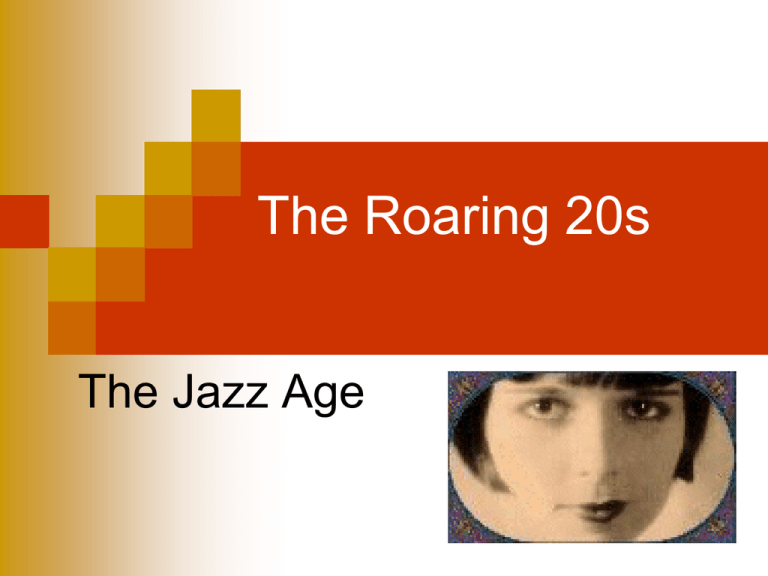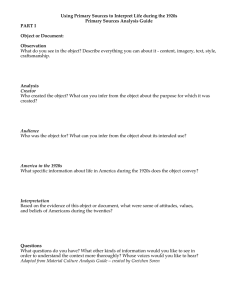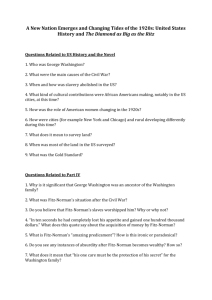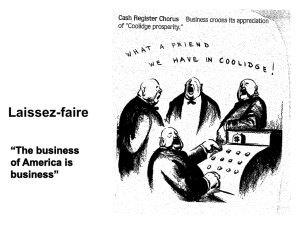The Roaring 20s The Jazz Age
advertisement

The Roaring 20s The Jazz Age From a cultural and historical perspective, the 1910s and 1920s were marked by a deep clash of cultures. During the previous 50 years the U.S. had changed from agrarian to industrial From town to city From Victorian to modern As usual the division was between those who embraced change and looked to the future with hope.. and those who idealized the past and resisted change. In an increasingly consumerbased society, leisure and pleasure were prized over hard work and self-denial. Automobiles and radios became “must have” items in American homes. By 1925, there was one automobile for every six persons in the country (as compared to one for every one hundred in Great Britain), …and by 1930 this had increased to one for every four people! With America’s love of cars came growth in related industries… The price of automobiles declined steadily until the mid-1920s so that many well-paid working families could now afford to purchase a car. And for the first time in history, large consumer items, like cars, could be bought on credit! America fell in love with the radio, as well. The first commercial radio station went on the air in 1921. By 1922, 3 million American households had radios! By the end of the decade, an estimated 40 percent of American families owned radios. Both these products served to connect remote communities, especially in rural areas; Automobiles brought mobility to both urban and rural consumers and radios provided access to information and opportunities. The automobile made stores accessible, and radios provided a means for businesses to advertise their products and their services. In the 1920s, the ability to produce and distribute goods on a mass scale… …aided by technological development and federal policies favoring industry, brought about a stabilization of the economy that led to wide prosperity. The historian Ellis Hawley, in his book The Great War and the Search for a Modern Order, notes that from 1922 to 1928 the index of industrial production climbed 70 percent! These factors created a selfperpetuating cycle: standardized mass production led to better machinery in factories, which led to higher production & higher wages, which led to more demand for consumer goods. Working people at many income levels experienced a rise in their standard of living. The popularity of automobiles and radios also encouraged the spread of chain stores around the country. The 1920s saw a proliferation of chain stores and department stores for consumers at all levels of income. Well-known chains that took advantage of the new market conditions included Sears & Roebuck, Woolworth's, Great Atlantic and Pacific Tea Company (A&P), Kroger's, J. C. Penney's. and Walgreen Drug. Among the most successful department stores were Macy's in New York and Wanamaker's in Philadelphia. Many companies organized extravagant advertising spectacles and other enterprises to attract consumers. The Macy's Thanksgiving Day Parade, a pitch for the children's toy market, was one example of popular merchandising. Businesses also enlisted the expertise of publicrelations agents. Every product was targeted for mass marketing techniques… Even previously unused enticements, like appealing to sex, became common in consumer advertising… Advertisers made the average citizen feel like the luxuries once reserved for the wealthy could now be obtained by everyone. Advertisers soon realized that the primary purchasers of consumer items were women! It was the woman of the house who sought products to make housework easier and more effective… The economic growth of the 1920s spurred the rise of consumer-advocate organizations and consumer-safety campaigns, as well... …like the Truth-in-Advertising Movement… … which pursued ethics in advertising. Others sought to educate consumers. The Better Homes Movement celebrated home ownership, home maintenance and improvement, while the Thrift Movement sought to teach children and citizens how to spend wisely. The National Consumers League sought to expose goods produced under exploitative, or unsafe working conditions, especially children. The culture of consumerism of the 1920s changed the politics of American society… … and set the tone for American attitudes about money in coming decades. Advertising was a new field, which encouraged people to “buy, buy, buy” Some of the major conflicts were over the role women would play in the new society… there was conflict over prohibition… and, of course, there was conflict over race and ethnic differences. With the end of The Great War, the U.S. entered a period of excess with the sacrifices of the past put firmly behind them. There was also a mood of discontent and fear, which led people to turn to the Republican party for security. Warren G. Harding was elected President using the slogan “Return to Normalcy” President Harding died suddenly in 1923, making Calvin Coolidge the new president. During the war, the 18th amendment was passed, outlawing the manufacture, sale and transportation of alcoholic beverages. The Volstead Act, passed to enforce prohibition was violated in a lot of the U.S. but statistics show that overall the consumption of alcohol did decline. While Temperance . groups led “the Great Experiment” “bootleggers and speakeasies” were rampant in the cities. This was another example of the great divide between traditional values and new morals. The Twenties became known as a time of lawlessness, with gangsters like Al Capone becoming “celebrities” in their own right. Other “celebrity” outlaws were Bonnie and Clyde, Machinegun Kelly, and Pretty Boy Floyd Mama may have been a Gibson girl, but daughter was a freer soul. Women insisted on a new role in the 1920s. Girls became “co-eds”, bobbed their hair, shortened their skirts, powdered their knees, wore make-up, smoked and drank. Women wanted to be like the “It” girl, and wanted their men to be “Sheiks” like Rudolf Valentino The Scopes Trial was just a symptom of the challenges to the religious beliefs of the “old morality” Pitting the country’s two greatest lawyers, William Jennings Bryan and Clarence Darrow, against each other, the trial was over teaching evolution in public schools. Racial tensions were high in the 1920s, there were several major race riots across the nation and the KKK had a resurgence in power and numbers. The Tulsa Race Riot of 1921 was one of the worst in American history… but it was certainly not the only one. There were 25 such riots in 1919. Omaha Chicago Much like the later 1950s, the 1920s had two definite sides, one fun and frivolous, and one darker which would lead to difficult times in the future.





